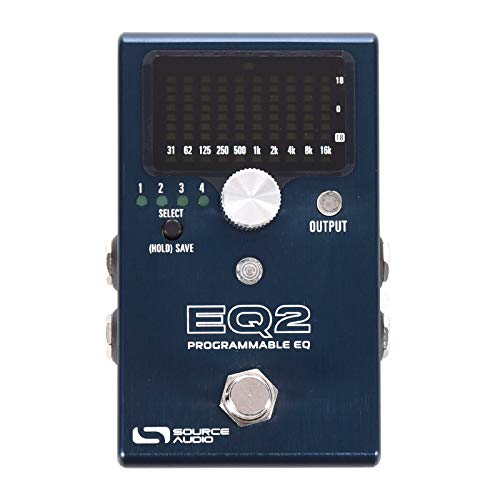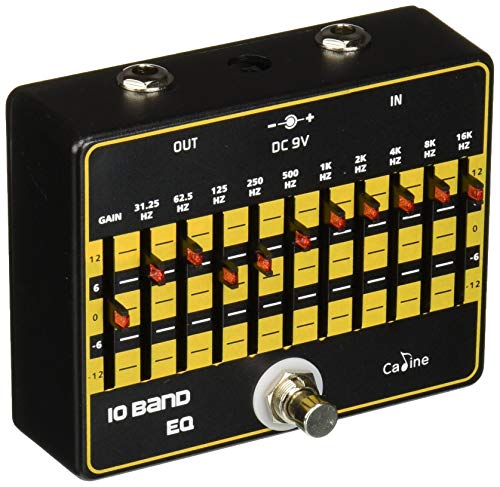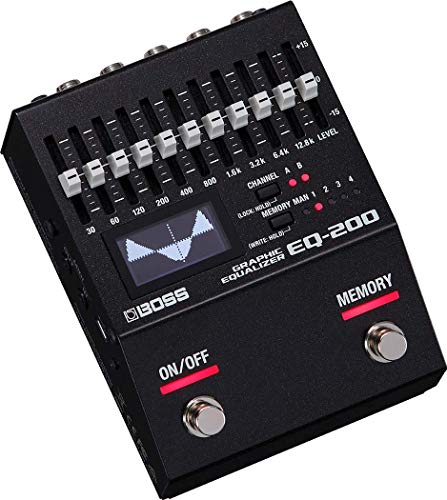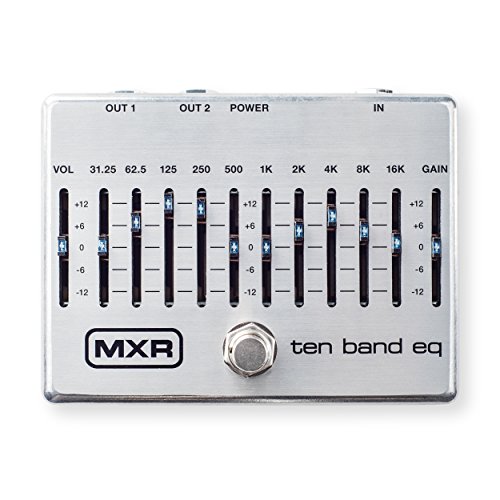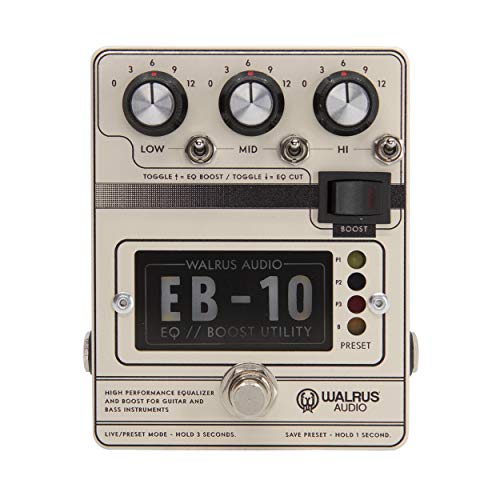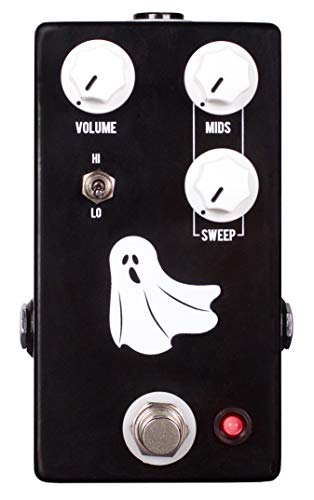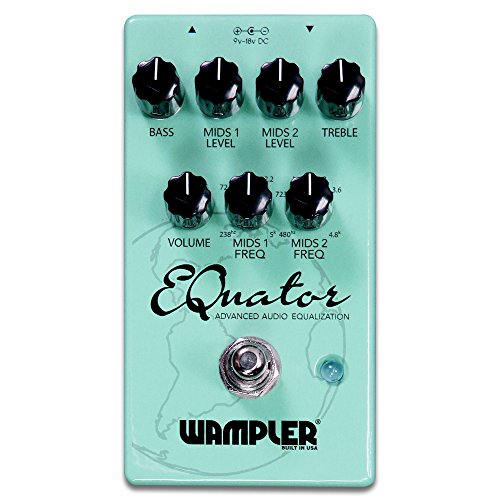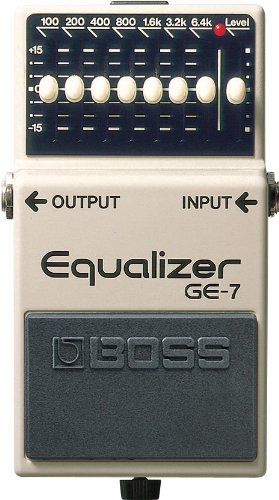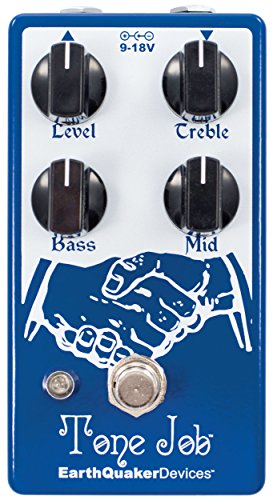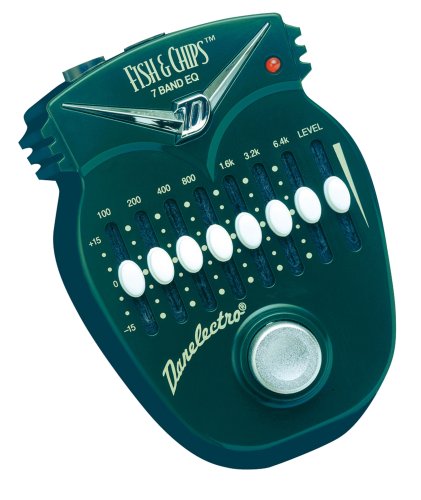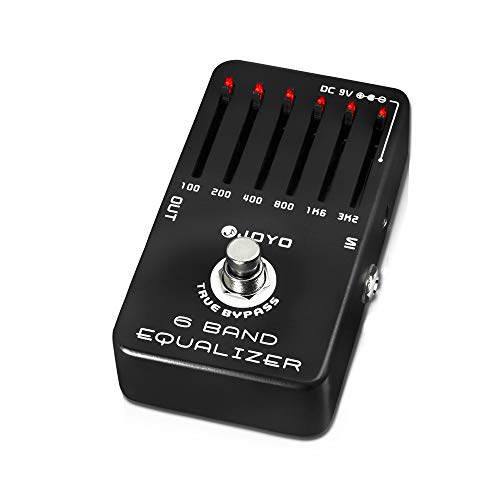11 Best EQ Pedals for Guitars
Equalizer pedals have been used by many famous guitarists to beef up their sound, or to scoop it entirely like Dimebag Darrell. These pedals come in all shapes and sizes, from simple 3-band graphic EQs to 10-band parametric ones, and some even have in-built tuners and boost functions.
That’s why we’ve listed the 11 best EQ pedals in this article and provided a buying guide as well, to save your time on research and spend more time playing.
Top Picks: 11 Best EQ Pedal Reviews
1. Source Audio EQ2 Programmable Equalizer - Best Overall
Specifications
Type: Graphic and Parametric EQ
- Range: 20Hz to 20kHz, 10-band
- Bypass: True or Buffered
- Power: 9V PSU
Source Audio is a manufacturer of boutique effects pedals that possess some of the most unique and advanced features a musician could need. The original Source Audio EQ was a huge hit, but now they’ve launched the EQ2 multi-band EQ pedal, with even more features, deeper programmability, and an overall easier experience for its users.
The Source Audio EQ2 provides a combination of both graphic and parametric equalizers, with a frequency range from 20Hz to 20kHz. It features 10 bands that can be assigned as you wish, with +/- 18dB of gain on either side, and a changeable ‘Q’ value from narrow to wide for more precision. On top of that, there’s an additional 12dB of volume boost, and 8 configurable presets that can be stored on the device. According to guitarist Pete Thorn (1):
The Source Audio EQ2 is super simple to use, but it also lets you go deep and do a whole bunch of tweaking and editing
What makes the SA EQ2 even more impressive is its deep-programmability using the Neuro Editor app, available for both desktops and mobiles. It lets you get into the nitty-gritty of the pedal, and lets you visually set the exact frequency band that you want, and you can even download user presets from the internet.
The pedal has a very compact aluminum build that’ll easily fit most pedalboards and will last for years. There are stereo inputs and outputs, which can be independently routed to different settings, and the bypass is switchable from true to buffered as you need it. The USB port lets you connect it to PC or mobile, and there’s even external expression control along with MIDI capabilities.
If you’re looking for the best EQ pedal that does it all, then look no further than the Source Audio EQ2 Programmable Equalizer. With both graphic and parametric EQs, insanely customizable 10-bands frequency range with 8 presets, 12dB of boost, MIDI programming, a robust build quality, an in-built tuner, and universal bypass, the EQ2 goes above and beyond any standard EQ pedal, making it the best guitar EQ pedal available today.
2. Caline USA CP-24 10-Band EQ Equalizer Guitar Effects Pedal - Budget Pick
Specifications
Type: Graphic EQ
- Range: 31.25Hz to 16kHz, 10-band
- Bypass: True
- Power: 9V PSU
Caline is a new manufacturer of guitar effects pedals and accessories, but their affordable products have already become popular due to their surprising quality. The Caline CP-24 is a 10-band graphic equalizer that gives you a lot of control over your sound in a compact box for a very reasonable price, and it gives tough competition to some of the best EQ pedals.
The CP-24 has 10 sliders for its 10-band EQ, plus another one on the left for overall gain control. The EQ bands available here are: 31.25Hz, 62.5Hz, 125Hz, 250Hz, 500Hz, 1kHz, 2kHz, 4kHz, 8kHz, and 16kHz. This lets you fine-tune your sound exactly as you want it, by boosting mids or increasing treble, or just to remove some noisy frequency bands. The gain slider lets you add some boost as well, up to 12dB, so it can function as a boost pedal too.
The Caline EQ pedal features a simple design that works well, and a good quality metal build that’ll survive some roughness. There are red LEDs on each slider to make it easier to function in the dark, and it has mono input and output. There’s true bypass here, which is a great offering at such a low price point, and it’s powered by a 9V DC power supply.
If you’re looking for a simple EQ pedal that quickly gets the job done on a low budget, then you should definitely check out the Caline CP-24. With 10 frequency bands that cover a broad spectrum, a +/- 12dB of gain, an aluminum-alloy build, and a true bypass, the Caline CP-24 is remarkably one of the best guitar EQ pedals at its price range.
3. Boss EQ-200 Graphic Equalizer - Most Versatile
Specifications
Type: Graphic EQ
- Range: 30Hz to 12.8kHz, 10-band
- Bypass: Buffered
- Power: AC Adaptor or Batteries
Boss is one of the most well-known names in the music industry, having produced some iconic effects pedals since the ‘80s. Their new EQ-200 pedal, a significant upgrade over the 20-series of pedals, was designed to offer a comprehensive solution for a guitarist’s equalizer needs, with in-depth customization and multiple presets that can be switched on the fly.
The EQ-200 is a 10-band graphic equalizer with 10 sliders on the top, where the available frequencies are: 30, 60, 120, 200, 400, 800, 1.6k, 3.2k, 6.4k, and 12.8k. However, you can change the entire range itself too, from 32Hz to 16kHz, or from 28Hz to 14kHz. There’s +/- 15dB of gain on each slider, as well as a master volume fader that can act as a boost. The LED display showcases the frequency waveform of the current patch for easy visualization. According to guitarist Rabea Massaad (2):
It’s a very advanced product, like all Boss products, and it makes it very easy to program four different patches and use them together.
The Boss EQ-200 is quite compact, given its impressive functionality, and it features an aluminum chassis that’s built to last. With stereo input/output, MIDI programming, external footswitches and expression control support, and a micro-USB jack, the EQ-200 is packed with versatility. It features 32-bit AD/DA conversion, 96kHz sampling, buffered bypass, and it can be powered by Boss’s AC adaptor or by 3 AA batteries.
If you’re looking for an amazing EQ pedal with deep customizability and lots of features to go through, then the Boss EQ-200 will serve you well. With four user presets, independent stereo routing with different EQ presets, a vivid LED display for instant visualization, and a comprehensive 10-band EQ, this is simply the most versatile EQ pedal there is.
4. MXR M108S Ten Band EQ Guitar Effects Pedal
Specifications
Type: Graphic EQ
- Range: 31.25Hz to 16kHz, 10-band
- Bypass: True
- Power: 18V PSU
MXR, a brand of Dunlop, is basically synonymous with high-quality effects pedals and accessories at consumer-friendly prices. The original MXR 10 frequency band EQ pedal was a very popular pedal amongst many famous guitarists, and now they’ve upgraded it even further. The new M108S features low-noise circuitry, true bypass switching, bright LEDs, and more to help you achieve the perfect tone.
The M108S has ten sliders to control its ten-band equalizer, and the available frequency bands here are: 31.25, 62.5, 125, 250, 500, 1k, 2k, 4k, 8k, and 16k, along with independent gain and volume controls. This lets you fine-tune the frequencies exactly as you need it, and it’ll also act as a boost pedal with up to 12dB of gain. The low-noise circuitry prevents any unwanted noise from creeping in too, and the boost is very clean.
This MXR EQ pedal is built with anodized aluminum, making it very sturdy, and it’s compact enough to fit most pedalboards too. There are bright LEDs on each slider, so it’s very easy to use it on dark stages, and the footswitch has true relay bypass as well as noiseless switching. It’s powered by an included 18V power supply, which allows for greater headroom.
If you’re looking for a great graphic equalizer with ten bands that’s very easy to use, you should certainly check the MXR M108S. With +/- 12dB of gain on each slider as well as independent volume and gain controls in a beautiful aluminum chassis with bright blue LEDs, the M108S is one of the simplest and yet best ten-band EQ pedals.
5. Walrus Audio EB-10 Preamp/EQ/Boost
Specifications
Type: Graphic EQ
- Range: 3-band
- Bypass: True
- Power: 9V PSU
Walrus Audio is a boutique manufacturer that designs some insanely innovative effects pedals and accessories for guitarists. The new Walrus Audio EB-10 is a combination of a preamp pedal, a 3-band EQ, as well as a boost, to provide guitar players with a compact stompbox solution for extensive tone-shaping needs.
The EB-10 is a 3-band graphic equalizer, and it has three knobs that control Lows, Mids, and Highs. There are toggle switches that let you control whether the frequency would be boosted or cut, and there’s 12dB of gain available here. It has two operating modes: Live and Preset; Live lets you change the knobs as you wish and hear the sound in real-time, whereas Preset will lock all the controls and let you switch between the three available preset slots.
The EB-10 allows you to switch between the three presets on the fly, which means you can use different presets for different guitars, and it even has a 10dB MOSFET boost switch for more crunchy gain. All this power is packed inside a rugged, die-cast aluminum body with a nice, aesthetic design on top of it, and it’ll easily fit most pedalboards. It features a true relay-bypass, and it’s powered by a 9V power supply.
If you’re looking for a single pedal that has a preamp, EQ, and a powerful boost, the Walrus Audio EB-10 is certainly a fantastic choice. With a 3-band EQ that’s easy to use, 12dB of boost along with an added 10dB of MOSFET gain, three presets to choose from, and a very cool, sturdy build, the EB-10 has a lot to offer for any serious guitarist.
6. JHS Haunting Mids EQ and Mid-boost Pedal
Specifications
Type: Parametric EQ
- Range: Mids
- Bypass: True
- Power: 9V PSU
JHS Pedals, a boutique pedal company, designs some great and inventive new products that are aimed to let guitarists craft good tones with ease. The JHS Haunting Mids is a mid-boost EQ pedal that also acts as a preamp, and it comes with a sweepable mid-range, a switchable bell curve, and some cool artwork.
The Haunting Mids has three control knobs for Volume, Mids (frequency boost in the mid-region), and Sweep (range of the frequency boost), along with a toggle switch between Hi and Lo. The sweepable range here is from 400Hz to 7.5kHz, and the toggle switch lets you choose between a broad or narrow Q value (bell curve). Essentially, this pedal is great for ensuring that your guitar’s midrange cuts through a mix and those soaring solos are heard properly.
The JHS Haunting Mids features a really cool ‘ghost’ artwork on it, with a sturdy aluminum build and a compact design to easily accommodate pedalboards. It features a true analog bypass, and it’s powered by a 9V power supply with 100mA of current draw.
If you’re looking for a great mid-range boost and EQ, then you should check out the JHS Pedals Haunting Mids. Its easy-to-use controls let you dial in great-sounding tones very quickly, which is a big bonus during live performances, and it has a simple build with a cool artwork that’ll look great on any guitarist’s pedalboard.
7. Wampler EQuator Advanced Audio Equalizer Guitar Effects Pedal
Specifications
Type: Graphic/Semi-Parametric EQ
- Range: 120Hz to 5.5kHz, 4-band
- Bypass: True
- Power: 9-18V PSU
Wampler, founded by Brian Wampler, makes some very crafty effects pedals that are designed to target the exact needs of guitar players. The Wampler EQuator is an advanced, 4-band equalizer that gives you immense control over your guitar’s midrange, while letting you tame any harshness in the highs and also acting as a great boost pedal.
The EQuator has a total of 7 control knobs, where 4 of them are for the midrange, and the others are Bass, Treble, and Volume. The Bass knob operates at 120Hz, Treble operates at 5.5kHz, while the midrange is semi-parametric. Mid 1 has a broader Q, and is sweepable from 238Hz to 5kHz, while Mid 2 is narrower and sweeps from 480Hz to 4.8kHz. By selecting the exact sweep you want and boosting/cutting specific frequencies, the EQuator offers a remarkable level of control over your guitar’s tonality.
The Bass and Treble knobs let you control any harsh highs or boomy bass tones as well, and the Volume acts as a clean boost. The pedal has a sturdy metal build that’s sure to last for years, and it also has an LED light to indicate the power state. It has a true relay bypass, and it’s powered by a 9V or 18V power supply, with 18V providing more headroom.
If you’re looking for a great semi-parametric graphic equalizer, then certainly consider the Wampler EQuator. With 7 control knobs on a compact that include 2 sweepable midrange bands with different Q values, along with a great clean boost and a rugged design, the EQuator is a pedal that’ll benefit any guitarist’s tone both on stage and in the studio.
8. BOSS GE-7 Seven-Band Graphic Equalizer Guitar Pedal
Specifications
Type: Graphic EQ
- Range: 100Hz to 6.4kHz, 7-band
- Bypass: Buffered
- Power: 9V PSU or Batteries
The second Boss product on this list (an indicator of just how good their products are) is the Boss GE-7, a seven-band portable stompbox equalizer. It’s a very simple pedal that’s worked well for many years now, featuring a classic Boss pedal design that’s easy to use and fits on all pedalboards, but also gives you a wide range of control options.
The GE-7 has 7 control sliders that sit across 7 frequency bands: 100Hz, 200Hz, 400Hz, 800Hz, 1.6kHz, 3.2kHz, and 6.4kHz. Each slider has up to 15dB of boost or cut, letting you adjust them as you please, and there’s also a master volume control that can act as a boost function for those screaming solos. This graphic equalizer helps you shape your tone exactly as you need it, from boosting mids and taming highs for leads, to fat and thick crunchy sounds for rhythm.
The GE-7 has the classic stompbox shape that Boss pedals have had for decades, with a big footswitch that’s easy to press and a rugged design to last for ages. It has mono input and output jacks on the sides, and it has a LED power indicator as well. It has Boss’s buffered bypass, and can be powered by 9V batteries or by a power supply.
If you’re looking for a great, compact seven-band equalizer that gives you control over your tone, then definitely check out the Boss GE-7. With +/- 15dB of boost or cut as well as a master volume control that’s very easy to use, and a rugged Boss design, this is a pedal that’ll feel like home for many guitarists.
9. EarthQuaker Devices Tone Job V2 EQ and Boost Guitar Effects Pedal
Specifications
Type: Graphic EQ
- Range: 3-band
- Bypass: True
- Power: 9-18V PSU
EarthQuaker Devices is a brand that’s well-known for high-quality guitar effects and many of their pedals are used by famous artists. The new EarthQuaker Devices Tone Job pedal is a graphic EQ and boost pedal designed to give you easy control over your sound and let you dial in some great-sounding tones within a few minutes.
The Tone Job has four knobs for Level, Treble (around 2kHz), Bass (around 500Hz), and Mid (centered at 1kHz). The volume knob allows you to drive the output 5 times its input level, hence providing some great boost power. The Treble and Bass knobs depend on the position of the Mid knob, and each knob provides up to 20dB of boost or cut, where the noon position is flat.
EarthQuaker Devices have a standard design format with rugged aluminum design and top-facing jacks, and the Tone Job follows suit. There’s an LED for power indication on dark stages, and it has a true relay bypass as well. It’s powered by a 9V power supply unit, and it’s recommended to use isolated supplies.
If you’re looking for a great 3-band equalizer with a lot of boost power, you should consider the EarthQuaker Devices Tone Job.
10. Danelectro DJ-14C Fish & Chips 7 Band EQ Mini Effects Pedal
Specifications
Type: Graphic EQ
- Range: 100Hz to 6.4kHz, 7-band
- Bypass: Buffered
- Power: 9V PSU
Danelectro is known in the guitar player community for making great-sounding pedals at very affordable prices, albeit with odd designs at times. The Danelectro DJ-14C ‘Fish and Chips’ pedal is a 7-band equalizer as well as a boost pedal, much like the Boss GE-7, and it has a distinctive shape that may be the cause of its name.
The DJ-14C has 8 sliders on top, of which 7 sliders control the equalizer in the frequency ranges of 100Hz, 200Hz, 400Hz, 800Hz, 1.6kHz, 3.2kHz, and 6.4kHz. There’s 15dB of boost or cut available on each slider, and another 15dB on the master volume fader. It’s a simple design that lets you adjust it exactly as you want, allowing for midrange boosts, treble cuts, bass boosts, and also acts great as just a clean boost.
The pedal, with its unique design, features a plastic build, so it will require some care while foot-stomping. There’s an LED indicator for the power state, which is powered by a 9V power supply. It has a buffered bypass, so it’ll act as a buffer even when switched off.
If you’re looking for a budget alternative to other 7-band EQ pedals, then the Danelectro DJ-14C is a good choice. It’s one of the best EQ pedals at its price range, offering a wide frequency range and great control, as well as 15dB of boost, in a decently built and unique-looking stompbox.
11. Joyo JF-11 6 Band EQ Guitar Pedal
Specifications
Type: Graphic EQ
- Range: 100Hz to 3.2kHz, 6-band
- Bypass: True
- Power: 9V PSU or Batteries
Joyo’s pedals have featured in several other articles here for their impressive sound quality and surprising affordability. The new Joyo JF-11 is a 6-band graphic equalizer pedal that’s somewhat inspired by MXR’s 6-band variant, and aims to offer extensive tone-shaping possibilities in a compact unit.
The JF-11 has 6 sliders on top that control its 6-band EQ in the frequencies of 100Hz, 200Hz, 400Hz, 800Hz, 1.6kHz, and 3.2kHz. Each slider has a small, red-colored LED inside to help you navigate the settings on dark stages. There’s no volume slider here though, so it can only equalize your guitar signal, and won’t act as a boost pedal. But with +/- 18dB of gain on each slider, you have enough room to adjust the frequencies as you like.
The JF-11 comes in a sturdy aluminum-alloy chassis to withstand all the foot-stomping action that’s thrown at it, and it’s compact enough to fit on most pedalboards. There’s an LED indicator to show the pedal’s working state, and it has true bypass as well (a big plus at this price). It can be powered by a 9V power supply or batteries.
If you’re looking for a 6-band EQ on a budget that gets the job done, the Joyo JF-11 is certainly worth a try. It’s a no-frills graphic equalizer that provides 6-bands with 18dB of boost or cut in a very compact and durable stompbox, and at its asking price, it couldn’t hurt your pocket to try one out.
Buying Guide: How To Choose The Best EQ Pedal For You
If you’re still not sure about which EQ pedal is best for you, then here are some important considerations to keep in mind before you make your decision:
Type: Graphic, or Parametric?
Most equalizer pedals come in two different types: Graphic EQ and Parametric EQ. Graphic equalizers are very easy to visualize, as they essentially break up the frequency spectrum into a fixed number of bands, and then these specific bands can be attenuated or boosted as needed. The width of a band is known as its ‘Q’ value, and these graphic EQs have fixed Q values for every band. For example, the MXR M108S is a 10-band graphic EQ pedal.
Graphic equalizers are easier and quicker to use, while parametric EQs give you more in-depth control and flexibility.
A parametric EQ on the other hand, lets you adjust the band’s frequencies exactly as you wish, and also lets you change the Q value, from broader or narrower as you require (3). The Source Audio EQ2 programmable EQ is an example of a parametric EQ that lets you adjust the frequency center and bandwidth of each band, giving you maximum control over your guitar’s tone.
Frequency Range
EQ pedals offer a wide variety of different frequency ranges and bandwidths, with some pedals offering just mid-boost or 3-band EQs, and some offering 7-band or 10-band equalizers. Generally, a guitar’s signal does not go below 80Hz or above 2kHz at standard tuning, so a frequency range of 100Hz to 2kHz is quite sufficient to control your guitar’s tone accurately. You may wonder then, why do 10-band EQs even exist?
EQ pedals with a wider frequency range give you greater command over the upper-frequency ranges which contain ‘transients’.
Transients are loud and sharp spikes of sound that register at very high frequencies (in the range of 4-8kHz), such as pick attacks and snare hits, and are responsible for much of the dynamics of music. Controlling these requires a greater range of frequency bands, and it’s crucial to tame them for a well-balanced sound. Depending on whether you have an electric, acoustic, or bass guitar, the range of the EQ pedal is important too.
Bypass
True bypass pedals, when bypassed, will route your guitar signal directly through the pedal’s circuitry, without undergoing any alteration. This preserves the integrity and quality of your signal, and when used in conjunction with buffer pedals, is a very useful thing.
Buffered bypass, on the other hand, will act as a buffer for your guitar signal, converting it from high impedance to low impedance, and ensures that there are no high-frequency losses that are common in long-cable pedalboard setups.
It’s generally advised to have buffer pedals at the beginning and end of your signal chain, to ensure that there is no high-frequency signal loss (due to high impedance), while the rest of the chain functions on true bypass, so that the signal integrity and quality are maintained. Hence, the type of bypass you need depends on your pedalboard setup and the length of cables running through it.
FAQs
You can put your EQ pedal in a variety of different positions on the pedalboard. If it’s placed right after your guitar, it will affect the tonality of your guitar, allowing you to change the dry signal. Some people use it after overdrive/distortion pedals to change the character of the distortion, and some use it at the end of the signal chain to control the frequencies and tonality of the overall sound, shaping it as required.
Yes, an EQ pedal is definitely worth it. An EQ pedal is often referred to as a ‘utility pedal’, and it can be used in a variety of ways. Its effect varies widely depending on where it is placed inside your signal chain, and it can be used sparingly for small adjustments or to completely redefine your tone. It’s an important tool to help your guitar stand out within a mix and cut through, while also refining the tone for professional, studio-grade work
The best equalizer setting for bass depends on your genre of music, style of play, and ultimately the tone you’re going for. If you’re going for a ‘boomy’ sound, you can boost up the lower frequencies of 50-100Hz, where if you want a ‘tight’ sound, you should boost some of the midrange and tame the highs. Rock and metal players prefer a nuanced setting on their bass guitar, wherein they boost certain frequencies and attenuate others for a balanced sound.
References
- THE TONE SWISS ARMY KNIFE! Source Audio EQ2 Programmable Dual EQ. Retrieved from: https://www.youtube.com/watch?v=unULQJLKg7I
- Get More From Your Amplifier | BOSS EQ-200. Retrieved from: https://www.youtube.com/watch?v=CvbCasrV5ro
- What is a Parametric EQ?. Retrieved from: https://www.presonus.com/learn/technical-articles/What-Is-a-Parametric-Eq

